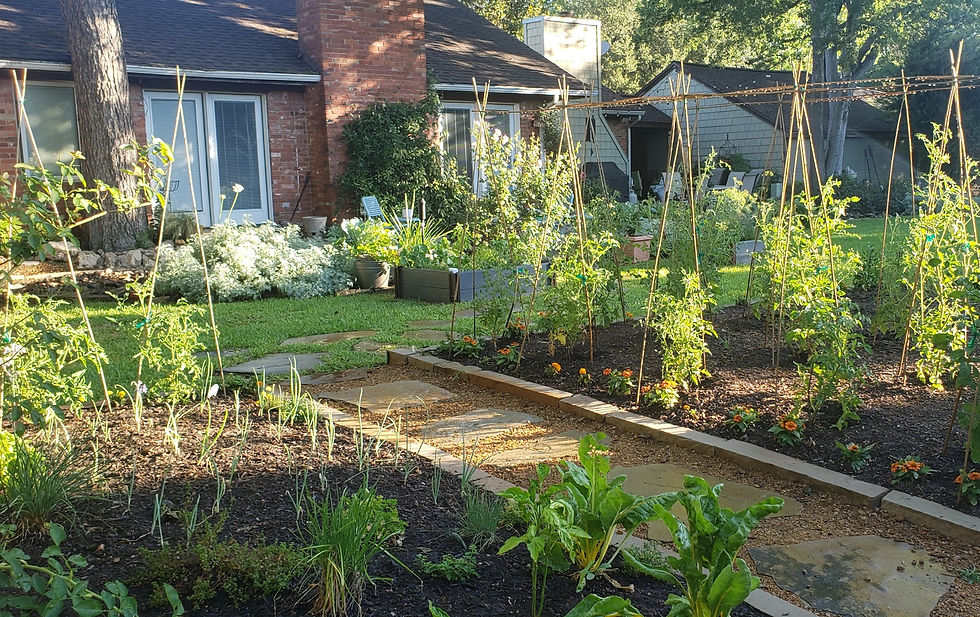All's Well That Ends Well
- Olga Arseniev
- Nov 12, 2020
- 3 min read

For those who remember Shakespeare’s play, the plot involves repugnant behavior, deception and manipulation. It ends well (enough), just leaves you hating the lead characters. Seems appropriate for this election year, doesn't it?
One thing that did end well is my experience with vegetable gardening this year. More specifically, our successful Black-eyed peas harvest. It's become yet another favorite plant – an edible ornamental. The plant is wonderfully easy to grow. It’s quick to germinate and highly tolerant of poor soil and drought conditions. It thrives in a hot, muggy climate.
What's most impressive is that like all beans, Black-eyed peas improve the soil they grow in. As part of the legume family of plants, they push nutrients and nitrogen back through their roots. Most plants love nitrogen-rich soil, especially when it happens organically. Beans are an excellent crop that benefits the vegetable garden.

A Lovely Legume: The Black-eyed pea blossom.

Black-eyed peas in the seedling stage.
I chose to grow Black-eyed peas because they’re meaningful to me. I know them as a Southern dish prepared and shared on New Year’s Day. You’re supposed to eat 365 peas – to make sure every day is prosperous and full of fortune. The symbolism is also appealing on a general level: Black-eyed peas are associated with humility. As the saying goes, “Eat poor on New Year’s Day and eat fat the rest of the year.”
It’s only November. But it’s also finally November. We’re nearing the end of an awful year. The harvest is done and we’re moving on. Next year is bound to be better – if for no other reason than the fact that I know more about how to grow vegetables. There's never an end in the garden, but the season has ended well indeed.

The bean patch this year.

The yield was nearly 10 cups of peas over 3 months.
Life in the Bean patch
Something especially appealing to naturalists is that a lot of little things live in and around the vines. The bean patch became a haven for ladybugs and Green Anole lizards. It also became an area for what I affectionately named the Council Meetings: beautiful Assassin bugs held what looked like regular meetings on the large, platform-like leaves. These bugs feed on aphids, flies, leafhoppers and medium sized caterpillars. I’ve read that it’s best to not come into close contact with one because they sting. But in my experience, they were respectful, entertaining tenants.

Two friendly visitors: The Bee and the Sharpshooter bug.

A Green Anole Lizard in a nearby plant.

Ladybugs enjoyed hanging out on the leaves.

Assassin Bugs. The bigger, grey ones are adults.
Interrupting the Council Meeting.

Marigolds and Zinnias around the garden help repel pests.
My All's Well That Ends Well Garden Stew
I prepared this with the final harvest of our black-eyed peas. The inspiration comes from the Hoppin' John recipe by Imma. Hoppin' John is one of the ways Southerners historically prepared black-eyed peas. The name is thought to come from a Haitian Creole corruption of "pois pidgeon" or "pidgeon peas" in English.

I picked the final dried beans and removed the peas. This recipe needs 16 oz.

Soaking can be done overnight or for 3-8 hours.

In a skillet, prepare smoked bacon and jalapeño Turkey Sausage. Set aside.

Sauté onions, chopped celery, sliced jalapeño, a bit of Serrano and Poblano peppers.

These are the spices and additional ingredients. Of course you can use fresh Thyme and Oregano. Smoked Paprika and red peppers is important.

Add 7 small to medium sliced okra.

Add the lovely collard greens – two large leaves, sliced small.

Combine all ingredients in a pot, except collard greens. Pour 2 cups of vegetable or chicken broth into the pot. Bring to boil. Turn to simmer.

Add collard greens, continue simmering for 45 minutes or so.

This meal can be served on a bed of rice. I personally like it just topped with sour cream and garlic chives with a slice of sourdough bread.
A general list of ingredients:
16 oz. dried black-eyed peas
2 slices of smoked bacon
1 cup of minced jalapeño Turkey sausage
1 big onion
Sliced elephant garlic clove
2 stalks of celery, diced
7 small-medium okra
1/4 small Serrano Pepper, sliced
1 small jalapeño pepper, sliced
1 poblano pepper, sliced
2 large leaves of collard greens, sliced
Olive oil
Sour cream
Garlic Chives
Spices:
Thyme, Coriander, Oregano, Red Pepper, Bay Leaf, Smoked Paprika, Salt

Thank you, Julie! The garden is resting (as I am too), but we're about to start up again.
I loved reading this. How wonderful that you have cultivated such a large garden, grown and harvested food, and creatively put together a wonderful dish--and provided the recipe! The photos are beautiful as well.